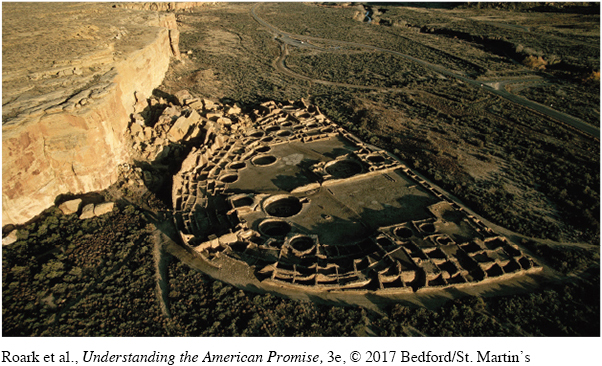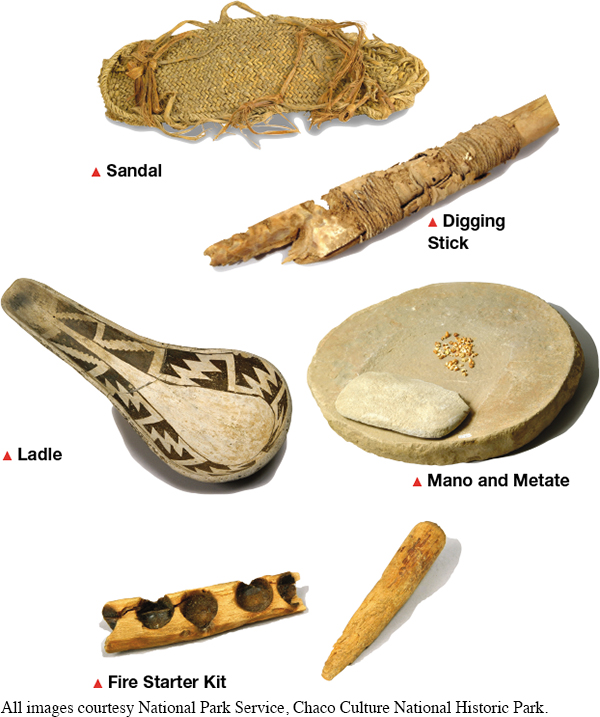ANALYZING HISTORICAL EVIDENCE: Artifacts of Daily Life in Chaco Canyon
ANALYZING HISTORICAL EVIDENCE
Artifacts of Daily Life in Chaco Canyon
Like archaeologists, historians study artifacts—physical objects—to investigate the past. Since ancient Americans did not use writing, their artifacts serve as documents of a sort that historians examine for evidence of ancient societies and cultures. Pictured here are artifacts made and used more than a thousand years ago by residents of Pueblo Bonito in Chaco Canyon, located in the arid region at the intersection of present-day Utah, Colorado, Arizona, and New Mexico.
The largest of many buildings in Chaco Canyon, Pueblo Bonito originally stood four or five stories tall and housed more than 600 rooms, including 35 kivas, the circular structures visible around the perimeter of the large plazas. Chaco residents covered each kiva with a roof, creating a darkened underground space for ceremonial rituals. The ceremonies remain a mystery, but less mysterious are the routines of daily life that for centuries sustained Chacoan people at Pueblo Bonito.
Among the many thousands of artifacts excavated by archaeologists at Pueblo Bonito are these objects Chaco residents used routinely in their daily lives. Imagine a woman at Pueblo Bonito setting out on a spring day to plant corn, her family’s most important food. She might strap on sandals, like the one shown here woven from fibers of the yucca plant. To dig a hole for planting corn seeds, the woman might use a digging stick like the one shown below, tipped by the horn of a mountain sheep and tightly bound with sinew to a cottonwood branch and covered with animal hide to protect the binding.
Once harvested and dried, corn needed to be ground in order to be cooked and eaten. Our imagined woman used the small flat stone (the mano) and the larger stone slab (the metate) to grind the corn. Some rooms at Pueblo Bonito contained numerous grinding stones.
To cook the cornmeal, the woman mixed it with water, perhaps using a ceramic ladle—like the one shown below crafted by a Chaco pottery maker—to dip water from a storage pot. To kindle a fire, she might use the Chacoan fire starter kit shown below. After heating the cornmeal gruel in a ceramic pot, she might use the ladle again to transfer servings into small bowls for eating.
Examine these objects and think carefully about them. Each object required a great deal of learning and experience to create it and use it effectively. Consider in detail, step by step, what activities went into the making and use of each artifact.[[LP Photo: P01.05 Pueblo Bonito, Chaco Canyon, New Mexico/


Questions for Analysis
ANALYZE THE EVIDENCE: What kinds of material, knowledge, skill, and activity were required to make and use each of these artifacts? What do the decorations on the ladle suggest about Chacoan artistry?
CONSIDER THE CONTEXT: What do these artifacts suggest about food production and consumption in Chaco Canyon? What do these artifacts reveal about the society and culture of Chacoan people?
ASK HISTORICAL QUESTIONS: How did Chacoan culture, as revealed by these artifacts, compare to the lifestyles of ancient Americans in other regions at about the same time? How do these artifacts differ from artifacts of Paleo-Indians and Archaic hunters and gatherers described in the chapter? What changes might account for the differences?
Source: All images courtesy National Park Service, Chaco Culture National Historic Park.
Understanding the American Promise 3ePrinted Page 15
Section Chronology